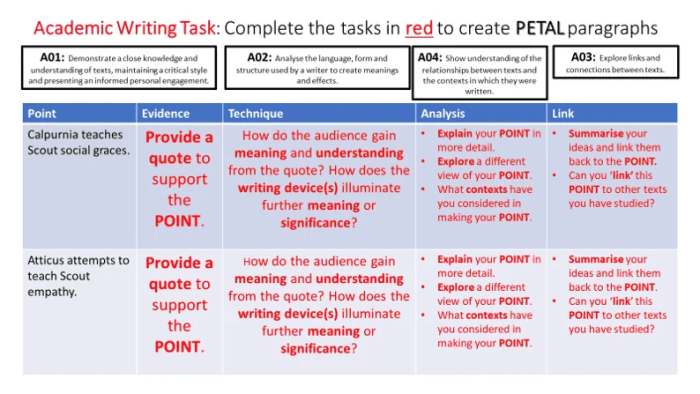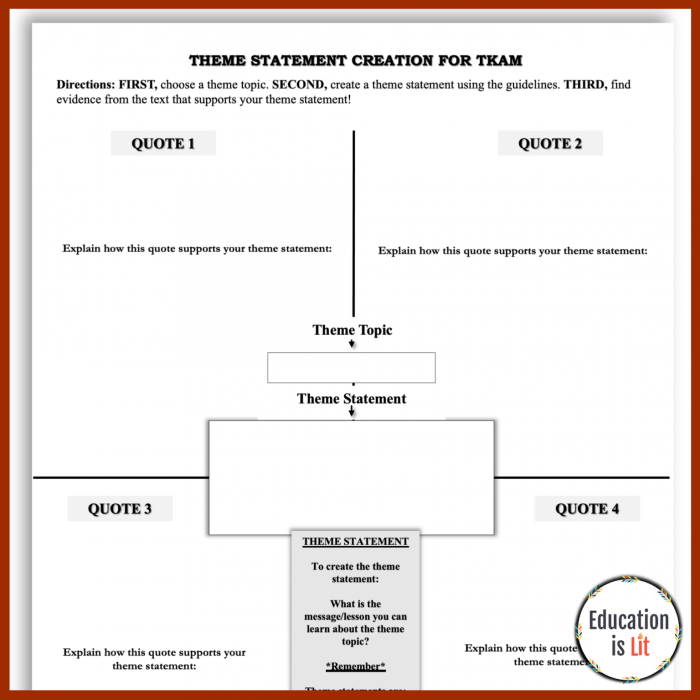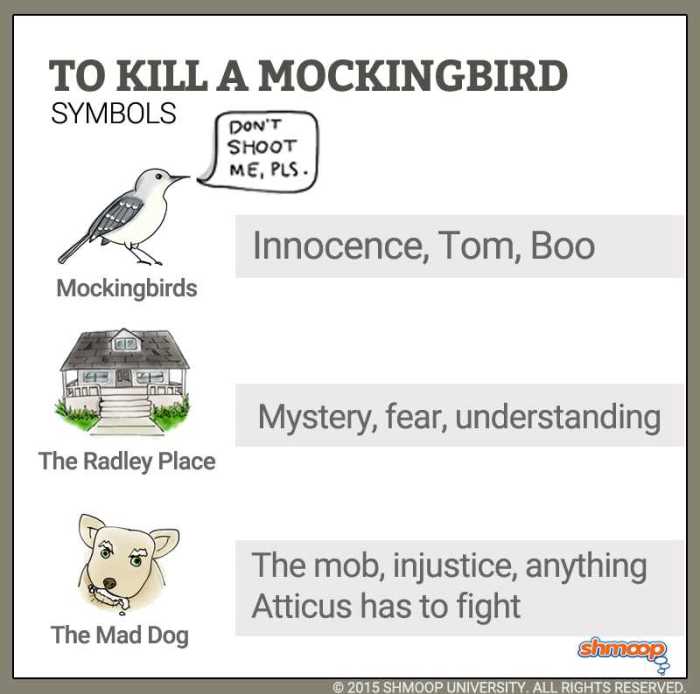Chart of learning experiences in to kill a mockingbird answers – Embarking on a literary journey with “To Kill a Mockingbird,” this comprehensive chart of learning experiences unveils the novel’s profound literary elements and character development, providing an immersive understanding of its enduring impact.
Through an analysis of key themes, symbols, and motifs, this chart delves into the novel’s intricate narrative, exploring how these elements shape the characters’ experiences and perspectives, ultimately conveying a timeless message about the complexities of human nature and society.
Key Literary Elements

To Kill a Mockingbirdis a novel that explores profound themes through its use of key literary elements such as symbols, motifs, and themes. These elements contribute to the novel’s overall message and impact, enhancing its depth and resonance with readers.
Symbols
- Mockingbird:Represents innocence and vulnerability, as well as the destruction of innocence in a prejudiced society.
- Boo Radley:Symbolizes the misunderstood and marginalized individuals in society, as well as the importance of empathy and understanding.
- Tom Robinson:Represents the victims of racial injustice and the flawed justice system that perpetuates it.
Motifs
- Prejudice and Racism:Explores the destructive effects of prejudice and the ways in which it corrupts society.
- Childhood and Innocence:Contrasts the innocence of children with the harsh realities of the adult world.
- The Importance of Empathy:Emphasizes the power of empathy and understanding in breaking down barriers and fostering compassion.
Themes, Chart of learning experiences in to kill a mockingbird answers
- Innocence and Prejudice:Explores the loss of innocence and the destructive power of prejudice in a society divided by race and class.
- The Importance of Empathy:Highlights the importance of understanding and empathy in overcoming prejudice and building a just society.
- The Power of Education:Emphasizes the role of education in shaping moral character and fostering critical thinking.
Character Development: Chart Of Learning Experiences In To Kill A Mockingbird Answers
To Kill a Mockingbirdfeatures a diverse cast of characters who undergo significant development throughout the novel. Their experiences and interactions shape their perspectives and contribute to the novel’s central themes.
Scout Finch
Scout is a young girl who narrates the novel. She is initially innocent and naive but gradually learns about the complexities of the adult world and the injustices that exist within it.
Jem Finch
Jem is Scout’s older brother. He is initially more mature and protective of Scout, but he also learns valuable lessons about prejudice and the importance of standing up for what is right.
Atticus Finch
Atticus is Scout and Jem’s father. He is a lawyer who represents Tom Robinson in court. He is a moral and ethical man who believes in justice and equality for all.
Boo Radley
Boo Radley is a mysterious neighbor who is feared by the children in the neighborhood. However, Scout and Jem eventually learn that he is a kind and gentle man who has been misunderstood.
Historical and Social Context

To Kill a Mockingbirdis set in the American South during the 1930s. The novel reflects the complexities of race, class, and morality in the United States during this time period.
Race and Prejudice
The novel explores the pervasive racism that existed in the American South during the 1930s. Tom Robinson’s trial highlights the injustices faced by African Americans and the flawed justice system that perpetuates racism.
Class and Inequality
The novel also explores the class divisions that existed in the American South. The Finches are a well-respected family, while the Cunninghams are poor farmers. The novel shows how class can influence people’s perceptions and opportunities.
The Great Depression
The Great Depression is also a backdrop to the novel. The economic hardship of the time period affects all of the characters in the novel and contributes to the tensions that exist within the community.
Symbolism and Allegory
To Kill a Mockingbirduses symbolism and allegory to enhance its themes and convey deeper meanings.
Symbolism
The novel uses a variety of symbols to represent its themes. The mockingbird represents innocence and vulnerability, while Boo Radley symbolizes the misunderstood and marginalized individuals in society.
Allegory
The novel can also be read as an allegory for the American South during the 1930s. The trial of Tom Robinson represents the larger struggle for racial justice in the United States.
Narrative Structure

To Kill a Mockingbirduses a complex narrative structure that contributes to its suspense, character development, and overall impact.
Flashback
The novel uses flashbacks to tell the story of Boo Radley and his relationship with the Finch children. These flashbacks provide insights into Boo’s character and help to explain his actions.
Multiple Perspectives
The novel is narrated by Scout Finch, but it also includes the perspectives of other characters, such as Atticus Finch and Boo Radley. This allows the reader to see the events of the novel from different angles and to gain a more complete understanding of the characters.
Themes and Meanings
To Kill a Mockingbirdexplores a number of central themes that are still relevant today.
Innocence and Prejudice
The novel explores the loss of innocence and the destructive power of prejudice in a society divided by race and class. Scout and Jem learn about the realities of racism and the importance of standing up for what is right.
The Importance of Empathy
The novel emphasizes the importance of empathy and understanding in overcoming prejudice and building a just society. Atticus Finch teaches his children the importance of seeing things from other people’s perspectives.
The Power of Education
The novel highlights the role of education in shaping moral character and fostering critical thinking. Atticus Finch believes that education is essential for creating a more just and equitable society.
FAQ Overview
What is the significance of the mockingbird in the novel?
The mockingbird symbolizes innocence, vulnerability, and the importance of empathy. Its death serves as a poignant reminder of the fragility of life and the devastating consequences of prejudice.
How does Scout’s perspective shape the narrative?
Scout’s childlike innocence and keen observations provide a unique lens through which readers experience the novel’s events. Her perspective highlights the complexities of race and morality in the American South.
What are the key themes explored in the novel?
The novel explores themes of innocence, prejudice, empathy, and the importance of standing up for what is right. These themes resonate with readers of all ages and cultures.